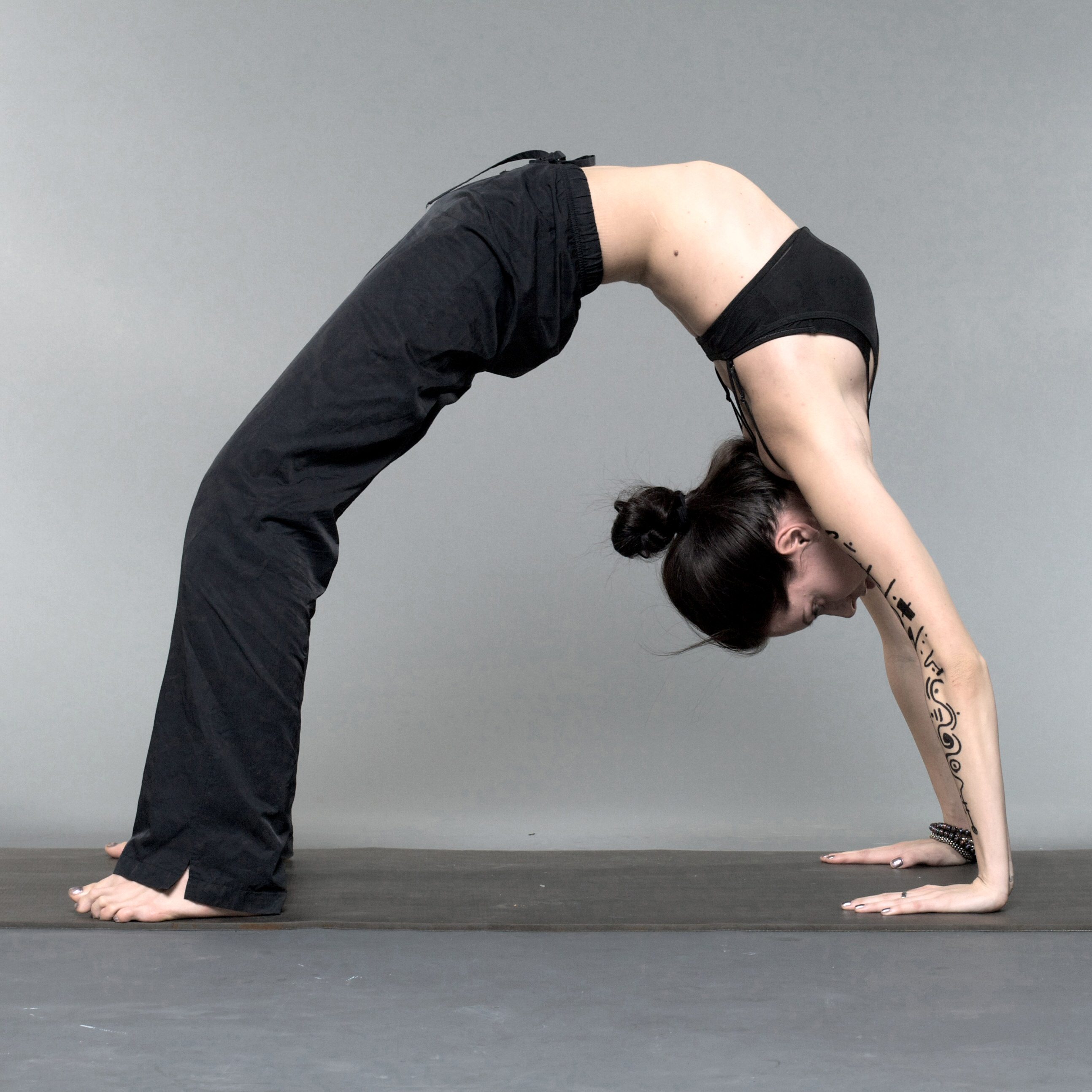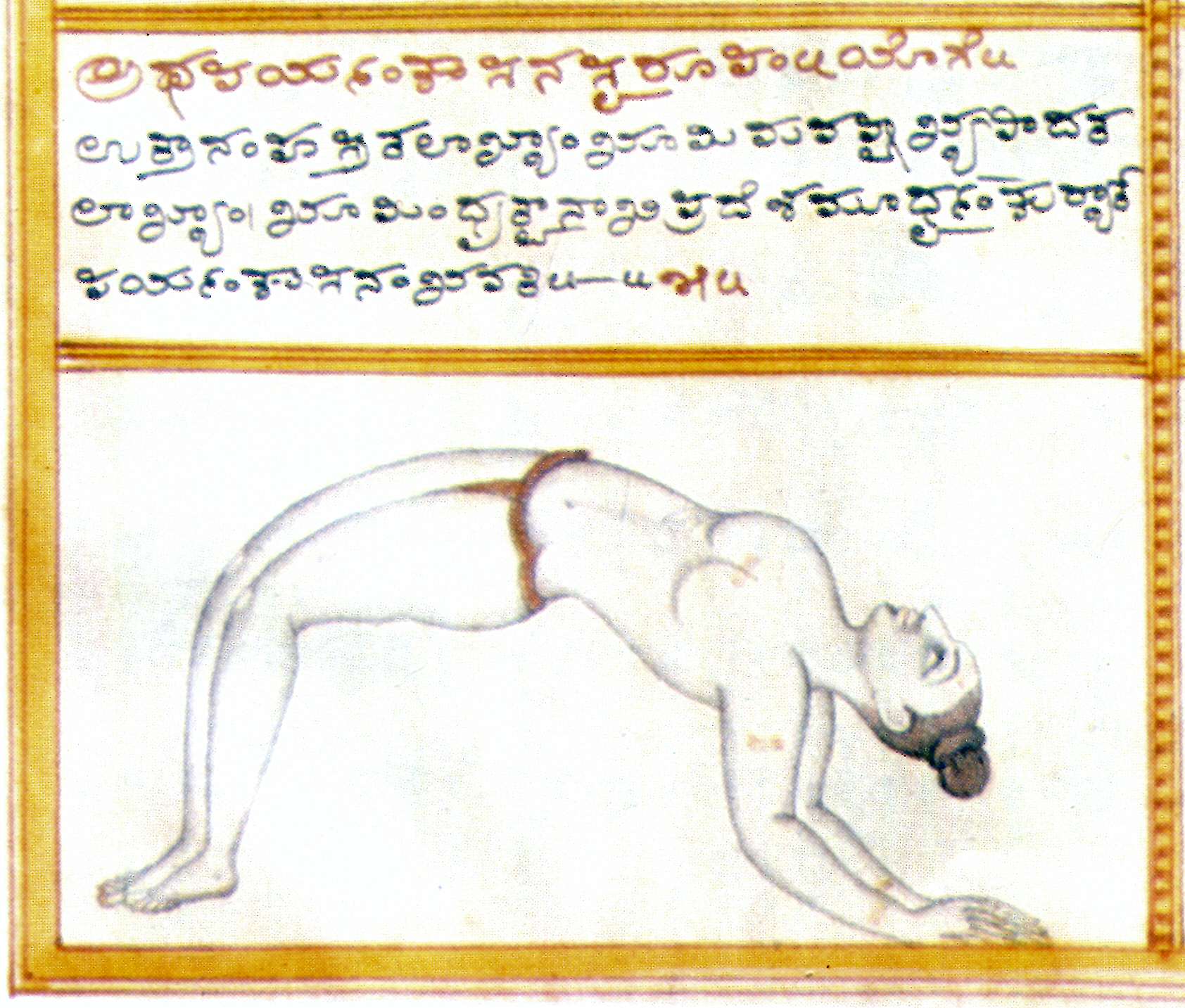Cakrasana on:
[Wikipedia]
[Google]
[Amazon]
 Chakrasana () or Urdhva Dhanurasana () is a backbending
Chakrasana () or Urdhva Dhanurasana () is a backbending
 The name Chakrasana comes from the Sanskrit words ''
The name Chakrasana comes from the Sanskrit words ''
File:Camatkarasana.jpg, Camatkarasana, Wild Thing Pose, a modern posture between Vasisthasana and Chakrasana
File:Eka-Pada-Chakrasana_Yoga-Asana_Nina-Mel.jpg, Russian yoga teacher Nina Mel, moving into Eka Pada Urdhva Dhanurasana
 People with tight shoulders or hips may be unable to move int
People with tight shoulders or hips may be unable to move int
Chakrasana
They can practise the pose using supports such as a pair of
File:Lululemon Yellow Yoga.jpg,
Technique
{{Hatha yoga Backbend asanas Inverted asanas
 Chakrasana () or Urdhva Dhanurasana () is a backbending
Chakrasana () or Urdhva Dhanurasana () is a backbending asana
An āsana (Sanskrit: आसन) is a body posture, originally and still a general term for a sitting meditation pose,Verse 46, chapter II, "Patanjali Yoga sutras" by Swami Prabhavananda, published by the Sri Ramakrishna Math p. 111 and late ...
in yoga as exercise
Yoga as exercise is a physical activity consisting mainly of asana, postures, often connected by vinyasa, flowing sequences, sometimes accompanied by pranayama, breathing exercises, and frequently ending with savasana, relaxation lying down or ...
. The one-legged variant is often chosen by yoga practitioners who wish to advertise themselves.
Etymology and origins
 The name Chakrasana comes from the Sanskrit words ''
The name Chakrasana comes from the Sanskrit words ''chakra
A chakra (; ; ) is one of the various focal points used in a variety of ancient meditation practices, collectively denominated as Tantra, part of the inner traditions of Hinduism and Buddhism.
The concept of the chakra arose in Hinduism. B ...
'', "wheel", and , "posture" or "seat". The name Urdhva Dhanurasana comes from the Sanskrit , upwards, and , a bow (for shooting arrows).
The pose is illustrated in the 19th century ''Sritattvanidhi
The ''Sritattvanidhi'' (, "The Illustrious Treasure of Realities") is a treatise written in the 19th century in the Mysore Palace, Karnataka on the iconography and iconometry of divine figures in South India. One of its sections includes instru ...
'' as ''Paryaṇkāsana'', Couch Pose.
Description
In the general form of the asana, the practitioner has hands and feet on the floor, and the abdomen arches up toward the sky. It may be entered from asupine position
The supine position () means lying horizontally, with the face and torso facing up, as opposed to the prone position, which is face down. When used in surgical procedures, it grants access to the peritoneal, thoracic, and pericardium, pericardial ...
or through a less rigorous supine backbend, such as Setu Bandha Sarvangasana
Setu Bandha Sarvāṅgāsana (), Shoulder supported bridge or simply Bridge, also called Setu Bandhāsana, is an inverted back-bending asana in hatha yoga and modern yoga as exercise.
Etymology and origins
The pose is named from the Sanskrit w ...
(Bridge Pose). Some advanced practitioners can move into Wheel Pose by "dropping back" from Tadasana
Tadasana (), Mountain pose or Samasthiti (; ) is a standing asana in modern yoga as exercise; it is not described in medieval hatha yoga texts. It is the basis for several other standing asanas.
Etymology and origins
Tāḍāsana is from th ...
(Mountain Pose), or by standing with the back to a wall, reaching arms overhead and walking hands down the wall toward the floor. Advanced practitioners may also follow wheel with any of its variations (listed below), or with other backbends, such as Dwi Pada Viparita Dandasana
Viparita Dandasana (, ) or Inverted Staff Pose is an inverted back-bending asana in modern yoga as exercise. It may be performed with both feet on the ground, or with one leg raised straight up.
Etymology and origins
The name of this asana com ...
, or by pushing back up to stand in Tadasana.
Preparatory poses are backbends such as Salabhasana
Salabhasana or Purna Salabhasana (; ), Locust pose, or Grasshopper pose is a prone back-bending asana in modern yoga as exercise.
Etymology and origins
The asana's name comes from the Sanskrit which means "grasshopper" or "locust".
The pose ...
(Locust), variants of Bhujangasana
Cobra Pose or Bhujangasana (; IAST: ) is a reclining back-bending asana in hatha yoga and modern yoga as exercise. It is also performed in a cycle of asanas in Surya Namaskar, Salute to the Sun, as an alternative to Urdhva Mukha Svanasana, Upwar ...
(Cobra, Sphinx), and Dhanurasana
Dhanurasana () is a back bending ''asana'' in ''hatha yoga'' and modern yoga as exercise.
Etymology and origins
The name comes from the Sanskrit words () meaning " bow", and () meaning "posture" or "seat".
A similar pose named Nyubjasana, " ...
(Bow).
Counter poses are forward bends including Paschimottanasana
Pashchimottanasana (), Seated Forward Bend, or Intense Dorsal Stretch is a seated forward-bending asana in hatha yoga and modern yoga as exercise. Janusirsasana is a variant with one knee bent out to the side; Upavishthakonasana has the legs stra ...
(Seated Forward Bend) and Balasana
Bālāsana () or Child Pose, is a kneeling asana in modern yoga as exercise. Balasana is a counter asana for various asanas and is usually practiced before and after Sirsasana.
Etymology and origins
The name comes from the Sanskrit words , " ...
(Child's Pose).
Variations
Many variations of the pose are possible, including: * Eka Pada Urdhva Dhanurasana (One-Legged Upward Bow or One-Legged Wheel): one leg is lifted straight up into the air. *Camatkarasana
Utthita Vasisthasana (sometimes shortened to Vasisthasana) () or Side Plank pose is a balancing asana in modern yoga as exercise.
Etymology and origins
The name of the pose comes from the Sanskrit extended, Vasiṣṭha, a sage, and , "pos ...
(Wild Thing Pose) has one arm lifted and the opposite leg straightened.
Learning the pose
 People with tight shoulders or hips may be unable to move int
People with tight shoulders or hips may be unable to move intChakrasana
They can practise the pose using supports such as a pair of
yoga brick
A yoga brick or yoga block is a smooth block of wood or of firm but comfortable material, such as hard foam rubber or cork, Yoga using props, used as a prop in yoga as exercise.
The use of wooden bricks to assist in alignment was introduced b ...
s placed against a wall under the hands or feet. A mat can be spread over the bricks to prevent slipping. Angled blocks may be more comfortable for the hands, as the slope reduces the strain on the wrists; alternatively, yoga bricks can be propped up on the wall's skirting board
In architecture, a baseboard (also called skirting board, skirting, wainscoting, mopboard, trim, floor molding, or base molding) is usually wooden, MDF or vinyl board covering the lowest part of an interior wall. Its purpose is to cover th ...
or other blocks. In a class, an assistant can stand by the practitioner's head (in place of the wall); the practitioner can then hold the assistant's ankles, and the assistant can hold the practitioner's shoulders.
The pose can be practised against a wall by standing a pace away from the wall, and facing away from it, with the feet about hip width apart. With the knees bent, the arms reach up and then back to the wall, and the head is leant back. If comfortable, the hands may be walked a little further down the wall and the arms and knees straightened.
In culture
On its 40th anniversary, ''Yoga Journal
''Yoga Journal'' is a website and digital journal, formerly a print magazine, on yoga as exercise founded in California in 1975 with the goal of combining the essence of traditional yoga with scientific understanding. It has produced live events ...
'' recalled seven ways it had covered Urdhva Dhanurasana, including a cover of Iyengar Yoga teacher Rama Jyoti Vernon Rama Jyoti Vernon (January 4, 1941 – November 23, 2020) was a yoga teacher and peace activist. She was a co-founder of ''Yoga Journal'', and of the California Yoga Teachers Association. She is considered one of America's yoga pioneers and was one ...
doing the pose in its first year, 1975 and Angela Farmer
Angela Farmer (born c. 1939) is a teacher of modern yoga as exercise. She uses a post-lineage yoga, non-lineage style that emphasizes the feminine, free-flowing aspect. She is known also as the creator of the first yoga mat.
Farmer was trained by ...
doing the one-legged variant in 1982.
The pose is often chosen by yoga practitioners who wish to advertise themselves: the Welsh author Holly Williams, writing about the commercialisation of yoga
Yoga in advertising is the use of images of modern yoga as exercise to market products of any kind, whether related to yoga or not. Goods sold in this way have included canned beer, fast food and computers.
Yoga is an ancient meditational spiri ...
in ''The Independent
''The Independent'' is a British online newspaper. It was established in 1986 as a national morning printed paper. Nicknamed the ''Indy'', it began as a broadsheet and changed to tabloid format in 2003. The last printed edition was publis ...
'', commented that she had "unfollowed everalpeople on Instagram
Instagram is an American photo sharing, photo and Short-form content, short-form video sharing social networking service owned by Meta Platforms. It allows users to upload media that can be edited with Social media camera filter, filters, be ...
whose artful shots of their Lycra
Spandex, Lycra, or elastane is a synthetic fiber known for its exceptional elasticity (physics), elasticity. It is a polyether-polyurea copolymer that was invented in 1958 by chemist Joseph Shivers at DuPont.
Name
The name ''spandex'', which ...
-clad one-legged wheel poses come with a barrage of hashtag
A hashtag is a metadata tag operator that is prefaced by the hash symbol, ''#''. On social media, hashtags are used on microblogging and photo-sharing services–especially Twitter and Tumblr–as a form of user-generated tagging that enable ...
s (#fitspo #yogaeverydamnday #beagoddess)."
Yoga in advertising
Yoga in advertising is the use of images of modern yoga as exercise to Product marketing, market products of any kind, whether related to yoga or not. Goods sold in this way have included canned beer, fast food and computers.
Yoga is an ancient ...
: pose by a Lululemon
Lululemon, commonly styled as lululemon ( ; all lowercase), is a Canadian-American multinational athletic apparel retailer headquartered in Vancouver, British Columbia, and incorporated in Delaware, United States, as Lululemon Athletica Inc. I ...
yoga model
See also
*Viparita Dandasana
Viparita Dandasana (, ) or Inverted Staff Pose is an inverted back-bending asana in modern yoga as exercise. It may be performed with both feet on the ground, or with one leg raised straight up.
Etymology and origins
The name of this asana com ...
, Inverted Staff pose, has the back similarly arched but the forearms on the ground.
* Bridge (gymnastics)
References
Sources
* *External links
Technique
{{Hatha yoga Backbend asanas Inverted asanas